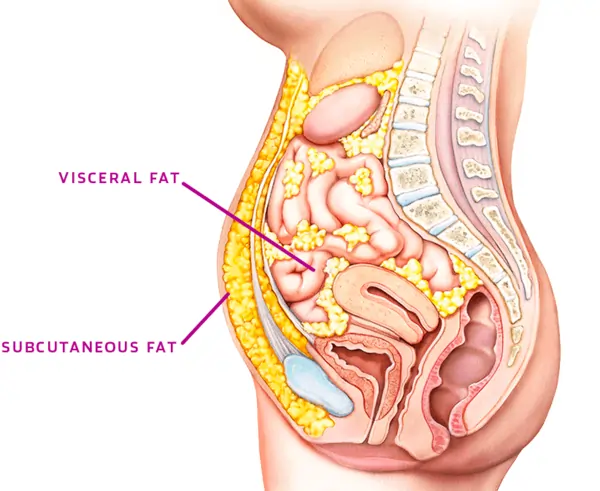Visceral Fat
What is a Visceral Fat?
Visceral fat refers to the type of fat that is stored deep within the abdominal cavity, surrounding vital organs such as the liver, pancreas, and intestines. Unlike subcutaneous fat, which is located just beneath the skin, visceral fat can be harmful to health due to its proximity to important organs. It has been linked to various serious health conditions, including heart disease, type 2 diabetes, high blood pressure, and certain cancers.
This type of fat is not only a physical concern but also an active metabolic tissue, meaning it can release inflammatory markers and hormones that influence the body’s processes, potentially leading to insulin resistance and other health problems. Reducing visceral fat through lifestyle changes such as diet, exercise, and stress management is crucial for maintaining overall health and preventing long-term diseases.
So, what exactly is visceral fat?
Visceral fat is a kind of body fat that is positioned deep within your abdominal walls, enveloping your organs. While having some visceral fat is healthy and protects your organs, excessive amounts can be harmful to your well-being. It is frequently referred to as “active fat” due to its activity in your body. Significant health problems including diabetes, heart disease, and stroke can be exacerbated by an excess of visceral fat.
Subcutaneous fat is the fat located directly under your skin, which you can pinch; visceral fat is deeper and not visible in that way. You can find visceral fat beneath your belly muscles and surrounding your internal organs.
Visceral fat wraps around the organs located deep in your abdomen, including the liver, intestines, and stomach.
It’s normal and healthy to have some visceral fat, as everyone does. This fat can offer protection to your internal organs. It is also known as “active fat” because it affects your body’s functions.
However, an excess of visceral fat is not beneficial for your health. It contributes to the possibility of contracting illnesses like diabetes, heart disease, and stroke.
Although having a larger belly might indicate the presence of this fat, it’s not visible from the outside. Additionally, visceral fat may be concealed even if you have a flat stomach. Generally, though, your visceral fat levels tend to rise as your overall body fat increases.
To accurately measure your visceral fat, expensive scans are required; however, doctors typically do not recommend such tests solely for that purpose. If you want to get a rough estimation at home, using a basic tape measure to check your waist size can give you some insight.
Comparing visceral fat to subcutaneous fat
Subcutaneous fat is located just beneath the skin. In contrast, visceral fat is positioned much deeper, nestled between your abdominal organs. Although visceral fat is too deep to be gripped in this manner, subcutaneous fat can be pinched. Subcutaneous fat can be found in various areas of your body, such as your hips, buttocks, thighs, and belly. Conversely, visceral fat is exclusively found deep within your abdomen, where most of your internal organs reside.
Approximately 90% of body fat has subcutaneous fat, with the remaining 10% being visceral fat.
Health risks associated with visceral fat
Excess body fat poses health risks, but visceral fat is particularly linked to increased chances of serious medical conditions. Conditions such as heart disease, Alzheimer’s, cancer, type 2 diabetes, stroke, and elevated cholesterol levels have all been closely associated with excessive abdominal fat.
Common reasons for weight loss difficulties include
Research indicates that visceral fat may produce certain proteins that contribute to the inflammation of bodily tissues and organs while constricting blood vessels. Blood pressure may rise as a result, and further health issues may arise.
Visceral fat and heart disease
Research has established a correlation between visceral fat and heart disease. For instance, a study found that women with proportionately larger waists to hip sizes faced double the risk of heart disease. Additionally, healthy women who did not smoke had a 10% increased risk of heart disease with every 2-inch increase in waist size.
Visceral fat and Alzheimer’s disease
Another study highlighted that individuals with greater amounts of belly fat and visceral fat face three times the risk of dementia, including Alzheimer’s disease, compared to those with less belly fat.
Visceral fat and cancer
Research has indicated a connection between visceral fat and certain cancers, including colorectal cancer. One study revealed that individuals with the highest visceral fat levels were three times more likely to develop precancerous polyps in their colons.
Visceral fat and type 2 diabetes
Higher levels of visceral fat are linked to insulin resistance, which increases the likelihood of developing type 2 diabetes.
Visceral fat and stroke
While the specific causes remain unclear, studies suggest that individuals with more visceral fat are at a greater risk for experiencing a stroke, often at a younger age.
Visceral fat and high cholesterol
There are direct associations between visceral fat and elevated cholesterol levels in the bloodstream, particularly “bad” LDL cholesterol.
Visceral fat and high blood pressure
likewise visceral fat have been linked to elevated blood pressure or hypertension.
Symptoms and causes
What are the signs of visceral fat? The most obvious sign of visceral fat is a venturing belly, though subcutaneous fat may also be present. Some studies suggest that an apple-shaped body—characterized by a potbelly—may signal the presence of visceral fat.
The factors contributing to a person’s weight are largely influenced by four components:
- Daily calorie intake.
- Daily calorie expenditure.
- Age.
- Genetics.
Individuals who consistently consume more calories than they burn daily are more prone to gain weight, including fat in the abdominal area.
Aging also plays a significant role. As people age, they tend to lose muscle mass, and this issue is more pronounced for those who do not engage in physical activity. The reduction in muscle mass slows down the body’s calorie utilization, making it harder to keep a healthy weight.
despite this they don’t gain weight overall, many women see an increase in belly fat as they age. This is probably due to a decrease in estrogen levels since estrogen influences fat distribution in the body.
Genetic factors can also affect a person’s likelihood of being overweight or obese and influence how fat is distributed in the body.
- Belly fat extends beyond just superficial layers.
- Illustration depicting areas where abdominal fat accumulates
- Enlarge image
- Abdominal fat
Because it includes more than simply the layer under the skin, abdominal fat is a cause for concern. Visceral fat, which is found deep within the belly and envelops internal organs, is included in what is known as subcutaneous fat.
Regardless of general body weight, having significant belly fat increases the risks of:
- High blood pressure.
- Excessive fat levels in the bloodstream.
- Sleep apnea.
- Cardiovascular disease.
- High blood sugar and diabetes.
- Certain types of cancer.
- Stroke.
- Fatty liver disease.
- Premature death from any cause.
Methods to Assess Visceral Fat
Accurately determining the amount and location of visceral fat typically requires expensive imaging techniques. However, several simpler methods can provide an estimation of visceral fat levels. If you possess more body fat than what your healthcare provider recommends, it’s likely that you also have a higher amount of visceral fat.
It is essential to understand, however, that no singular measurement can provide a complete assessment of your health. If you are concerned about potential health risks, consult your physician for recommended tests.
Focusing on established methods to enhance well-being and health is more beneficial than concentrating on body size or shape.
Waist circumference serves as a straightforward method for a rough estimate. Keeping your abdomen relaxed, record a measurement around your waist over the belly button. Excess visceral fat may be determined by a waist size of 35 inches or more in women and 40 inches in males. Caution: This is a basic tool, especially for larger individuals. For those of Asian heritage, the threshold for visceral fat is lower, at 31.5 inches for women and 35.5 inches for men.
Body Mass Index (BMI) is a calculation that compares weight to height. Online calculators facilitate this calculation. Generally, a BMI of 30 or above is classified as obese for someone 5 feet 9 inches tall. For Asian Americans, a BMI of 23 or above could signal a potential concern. A higher BMI may imply more visceral fat than is acceptable.
Caution: BMI can be an imperfect gauge of fat as it doesn’t account for variations in body composition (the ratios of fat, muscle, and bone) and shape, which differ among races, ethnicities, genders, and ages. While BMI can offer insights, it cannot independently measure total body fat or visceral fat or determine overall health.
By measuring the waist and hips, and then separating the waist circumference by the hip measurement, the individual may be able to determine the hip-to-waist ratio. Excess abdominal fat, including visceral fat, may be characterized by a ratio of more than 0.85 for women and 0.90 for males. However, research suggests that a simpler waist measurement might be just as effective.
Your body shape can provide additional clues. By looking in the mirror, you can identify where your body typically stores fat. Individuals with an apple shape—characterized by a larger upper body and slimmer legs—often have higher levels of visceral fat. This body type is more frequently observed in men, while women commonly have a pear shape, featuring larger hips and thighs.
Studies indicate that having more upper body fat poses greater health risks, which may partly explain why women generally have longer lifespans than men.
The only accurate method for determining the precise amount of visceral fat is imaging methods. If any doctor recommends an MRI or CT scan for another related medical issue, these tests can also give you a detailed image of your visceral fat.
Management and Treatment
How can you eliminate visceral fat?
The most effective method for reducing visceral fat involves adopting a healthy lifestyle. You can decrease your visceral fat levels by following the same dietary and exercise strategies that help with weight loss and lowering overall body fat. Methods to diminish visceral fat include:
Physical activity: Aim to engage in exercise for a minimum of 30 minutes each day. This can encompass aerobic or strength-building workouts. High-intensity interval training (HIIT) has become a favored option. HIIT sessions alternate between intense effort and brief recovery periods. This workout style offers both resistance and aerobic training, aiding in faster fat-burning.
Whenever possible, exercise for at least 30 minutes daily. Don’t forget to incorporate aerobic and strength training activities.
Cardio includes aerobic activities such as:
- circuit training
- cycling
- running
- These will expedite fat burning.
Strength training gradually increases calorie burn as your muscles strengthen and require more energy. Ideally, aim for 30 minutes of cardio five days a week and perform strength training at least three times a week.
Adopt a nutritious diet: A healthy eating plan consists of lean proteins, whole grains, low-fat dairy products, fruits, and vegetables. Get rid of trans fats, refined sugars, salt, and processed meals. Low-carb diets like the ketogenic (keto) diet can aid in reducing visceral fat by retraining your body to utilize fat as its primary fuel source instead of carbohydrates. It’s also critical to establish a balanced, healthful diet.
Whenever possible, remove processed high-sugar items from your meals and include more lean proteins, vegetables, and complex carbohydrates such as sweet potatoes, beans, and lentils. Low-carb diets, including the keto diet, may also assist in losing visceral fat.
Healthy lifestyle: The hormone cortisol, which is linked to stress, can raise the accumulation of visceral fat in your body; hence, minimizing stress in your life can facilitate fat loss. Engage in practices such as meditation, deep breathing, and other stress-reduction techniques.
Stress: Stress can also lead to excessive visceral fat formation. This happens because when an individual experiences stress, their body releases a hormone called cortisol, which leads to increased storage of visceral fat. Some healthcare professionals suggest that those with significant visceral fat levels should focus on reducing their stress.
Utilizing relaxation methods, such as meditation and deep breathing, along with other stress management strategies can be helpful in efficiently reducing visceral fat.
Intermittent fasting: This weight loss method involves alternating between periods of eating and fasting, and it could assist in lowering visceral fat levels.
Good sleep practices: Ensure you get adequate sleep. Insufficient sleep may elevate the risk of accumulating more visceral fat. Every 24 hours, get regular 7 to 8 hours of sleep.
Mitigate stress levels: Stress stimulates the release of cortisol in your body. Increased visceral fat storage results from the body’s “fight-or-flight” response being triggered by elevated cortisol levels. Consider trying yoga or meditation to manage your stress.
Limit alcohol consumption: Excessive drinking may result in heightened levels of stored visceral fat in your body.
Be mindful of portion sizes. Even when you choose healthy options, calories can accumulate quickly. At home, reduce the size of your servings. In restaurants, consider sharing meals or consuming half of your dish and taking the rest to go.
Avoid sugary beverages. Instead, choose unsweetened beverages like water.
Continue to be active: The Department of Health and Human Services advises most healthy adults to participate in strenuous aerobic exercise, like jogging, for at least 75 minutes per week or moderate aerobic activity, like brisk walking, for at least 150 minutes per week.
Make an effort to attend two or more strength training sessions each week. If your goal is to shed pounds or achieve specific fitness objectives, you may need to increase your exercise frequency. Both strength training and high-intensity interval training (HIIT) have been shown to help reduce belly fat.
Consequences of visceral fat
Visceral fat can begin to lead to health issues almost immediately. It can heighten insulin resistance, even in individuals without a history of diabetes or prediabetes.
Studies indicate that visceral fat may contribute to insulin resistance. Numerous studies suggest this occurs because visceral fat releases retinol-binding protein 4 (RBP4), a protein that enhances insulin resistance.
Visceral fat can also swiftly elevate blood pressure.
Most crucially, having an excess of visceral fat raises the likelihood of developing various serious and potentially life-threatening health conditions. These include:
- heart attack and heart disease
- type 2 diabetes
- stroke
- breast cancer
- colorectal cancer
- Alzheimer’s disease
Living With…
When should I consult my healthcare provider?
Regular check-ups with your healthcare professional are essential. They are able to track your visceral fat levels as well as your body fat percentage. If you measure your body fat at home and find your results exceed recommended levels, schedule an appointment with your provider. They can discuss your health risks and suggest a suitable diet and exercise regimen for you.
If you are a man with a waist measurement greater than 40 inches, or a woman with a waist larger than 35 inches, arrange to see your doctor promptly to discuss possible health risks and lifestyle modifications.
Your doctor can perform tests such as blood tests or an electrocardiogram (ECG or EKG) to evaluate health risks connected to elevated visceral fat levels.
Men and women fitting these descriptions may want to consult a doctor to assess their visceral fat levels, address potential risks, and receive guidance on making health and lifestyle adjustments to reduce visceral fat.
Some healthcare providers may conduct blood and other tests or refer individuals to a nutritionist or dietitian.
Outlook
Visceral fat is not visible, so we may not always be aware of its presence. This makes it particularly hazardous. However, it is generally preventable. Leading a healthy, active, and low-stress lifestyle can aid in preventing excess visceral fat from accumulating in the abdominal area.
Because visceral fat is difficult to detect, it can be difficult to determine whether a person has too much of it. Given the serious health risks linked to it, it is vital for those who suspect high levels of visceral fat to seek professional health advice.
Typically, it is feasible to avoid excessive visceral fat by adopting a healthy and active lifestyle.
Individuals who do possess harmful amounts of visceral fat can lower their levels through positive lifestyle modifications. These changes may involve consuming a nutritious, low-fat diet, increasing physical activity, and managing stress effectively.
FAQs
How can you decrease visceral fat?
You can effectively reduce your visceral fat by following the same diet and exercise strategies implemented for weight loss and lowering overall body fat. Exercise, eating a balanced diet, intermittent fasting, getting better sleep, controlling stress, and drinking less alcohol are all ways to reduce visceral fat.
Is visceral fat beneficial or detrimental?
Visceral fat can contribute to health complications such as elevated blood pressure, heart disease, diabetes, and certain cancers. It typically results from consuming more calories than you expend and having insufficient physical activity. Excessive visceral fat may be indicated by a waist measurement of 80 cm or more for women and 94 cm or more for males.
What type of exercise can eliminate visceral fat?
Research suggests that both aerobic exercises (like brisk walking) and strength training (using weights) can help diminish or prevent the accumulation of visceral fat. Targeted exercises, such as sit-ups, can strengthen abdominal muscles but do not effectively reduce visceral fat.
How to reduce visceral fat in 2 weeks?
18 Effective Strategies to Lose Belly Fat (Supported by Research)
Consume a considerable amount of soluble fiber. …
Avoid munching on anything that contains trans fats.
Limit your alcohol consumption. …
Follow a high-protein diet. …
Decrease your stress levels. …
Avoid excessive sugary foods. …
Engage in aerobic activities (cardio) …
Reduce carbohydrate intake, particularly refined carbs.
Is visceral fat challenging to eliminate?
The same lifestyle changes you would adopt for improved health or weight loss will also lower your visceral fat if it is excessive. Keep moving. Exercise can assist in shedding both visceral and subcutaneous fat that is visible and pinchable. Additionally, combining weight loss through diet with exercise can help maintain that loss.
Which beverages assist in burning belly fat?
9 beverages that expedite the burning of belly fat
Green Tea. Full of antioxidants, green tea enhances metabolism and facilitates fat burning, especially around the abdominal area. …
Lemon Water. …
Apple Cider Vinegar. …
Herbal Tea. …
Fenugreek Water. …
Ginger Tea. …
Coconut Water. …
Detox Water.
References
- Visceral Fat. (2024, May 1). Cleveland Clinic.
- https://my.clevelandclinic.org/health/diseases/24147-visceral-fat
- Visceral Fat: What Is It? WebMD. https://www.webmd.com/diet/what-is-visceral-faGotter, A.
- (2021, January 31). Visceral Fat. Healthline. https://www.healthline.com/health/visceral-fat
- What is the most effective method for reducing visceral fat?
- https://www.medicalnewstoday.com/articles/3209294 doctor-approved ways women can fight belly fat. (n.d.). Mayo Clinic. https://www.mayoclinic.org/healthy-lifestyle/womens-health/in-depth/belly-fat/art-20045809





12 Comments